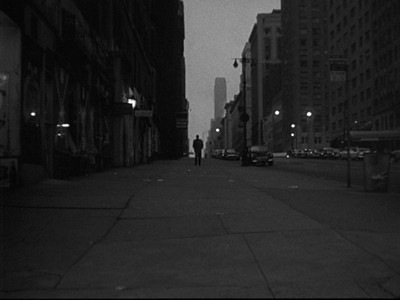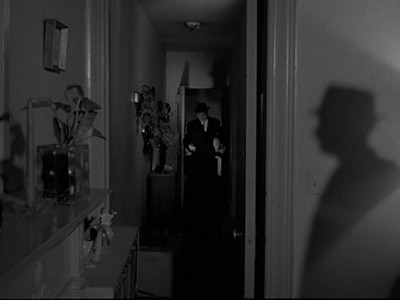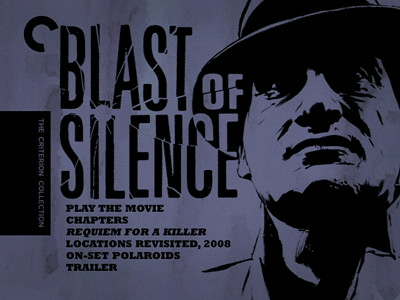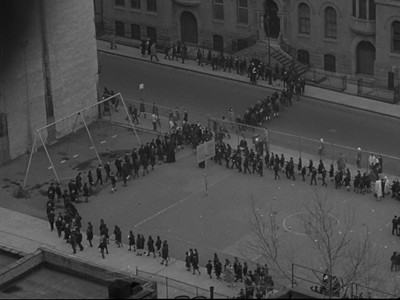
I was fortunate enough to see Blast of Silence sometime back in the mid-1990s when it was part of one of the then-regular film noir festivals at Cinema 21 in Portland. I would buy a book of tickets the week before the shows and try to catch every film in the line-up I had not seen before, sitting in the front row until my butt was numb and my eyes bleary. Blast of Silence was an oddity, as I had not even heard of it, nor seen in mentioned in any noir books, and its 1961 release date placed it much later on the historical timeline than most of the other fare. This unrefined gem was a real surprise, a quick shock to the system that didn't hold back, like a point-blank meeting with a snub-nosed revolver.

Made on the cheap by writer/director/star Allen Baron, there is no other film like Blast of Silence, an independently made hardboiled crime picture. You can tell right away that it's not going to be the same old production. Opening on an almost entirely black screen, it's hard to tell if the pinprick of light at the center is supposed to be there or if it's some kind of problem with the print. As the white circle shakes and begins to come closer, the gravelly voice of B-movie perennial Lionel Stander seems to address the viewer directly, speaking in a second-person "you." He speaks of your birth, how it hurt, how your mother screamed, and even how the doctor slapped your bare bottom as the camera finally breaks through and shows the inside of Penn Station. New York has been rushing toward you the whole time. Most Hollywood directors used train tunnels as a metaphor for sex, Baron births himself out of that underground canal, stepping onto the platform as a cold-hearted killer.
Coming in from Cleveland for a yuletide killing, Frank Bono is a solitary hitman who finds solace in the work he does. The voiceover continues, acting as a kind of taunting conscience, egging Frank on while also exposing his Freudian hang-ups. He grew up in an orphanage, he has painful memories of Christmas, he doesn't particularly care for women and he definitely hates his father. What he likes is being alone and the peace when the voice in his head goes quiet.
Blast of Silence follows Frank as he plans his hit. He cases the target (Peter H. Clune), buys a gun from a repugnant former colleague (Larry Tucker), and searches for the best possible angle to do his job. Baron shoots on the streets of Manhattan, using real nightclubs and apartment buildings to capture the quirky details of life in the city, on the outside (who is on the streets, where they go) or the inside (where someone hides his money, the gifts we bring a lover). (There is at least one constructed set, an apartment used for a party.) Cinematographer and producer Merrill Brody has a few rough stylistic edges, but even they serve to add to the from-the-ground feeling of the production. He makes the most of cramped spaces, using natural shadows for improvised composition. Given the documentary style and the warped voiceover, Blast of Silence is a bit like the less-sophisticated, knob-kneed cousin of Jules Dassin's The Naked City and the TV show that spun off from it.

I wondered at one point what the movie might be like without the narration. Written by Waldo Salt separately from Baron's screenplay and penned under the name Mel Davenport, it's ever-present, even moreso than the jazzy Meyer Kupferman score. Take it away, and Blast of Silence would be more like one of Jean-Pierre Melville's Eastern philosophy crime pictures. Yet, without it, Baron would not be able to convey the sense that something is dogging Frank. This job is the assassin's unraveling. Running into a guy who used to bully him at the orphanage (Danny Meehan) and his sister (Molly McCarthy), Frank lets his guard slip. He begins to make mistakes, to yearn for things that only get in the way for a man in his profession. The hard edges get soft, he feels loneliness at the holidays and regrets for the past just like the rest of us. There are only two options left for Frank to get the silence he craves: get the job done or get out altogether. Not for nothing does Baron play Frank as stony and stiff, looking almost unprofessional next to the other actors; they are more mannered and lively, real characters played by real people, while Frank is just a shell.
There are films with more polish than Blast of Silence, but that's okay. In some ways, the unsanded corners of this film put the boot into old film noir and how the bad guys were prettied up. Inside Frank Bono's head, we hear about hate and pain and the things a man can't escape, film noir concepts that weren't always given those blunt terms. Shot as it was, Allen Baron's movie brings the struggle to life, illustrating the need to get ahead and to get the filthy jobs done. The fact that Baron and Merrill and the rest got theirs done, putting together a one-two punch of a film, is illustration enough of what that means.

Blast of Silence - Criterion Collection is packaged in a clear plastic case with printing on all sides of the cover. The front image, menu design, and all of the interior images were done by comics artist Sean Phillips, whose own Criminal

Was the image of the children Frank sees leaving an orphanage intentionally put together so the streams of kids formed a swastika, underlining Frank's loathing of the system in which he grew up? I noticed it when I was watching the movie, and was happy then to hear in the documentary in the disc's extras that he did put it in there on purpose, though its capturing was an accident. It was a natural occurrence Baron's painterly eye could not let pass.
***
For technical specs and special features, read the full article at DVD Talk.

No comments:
Post a Comment